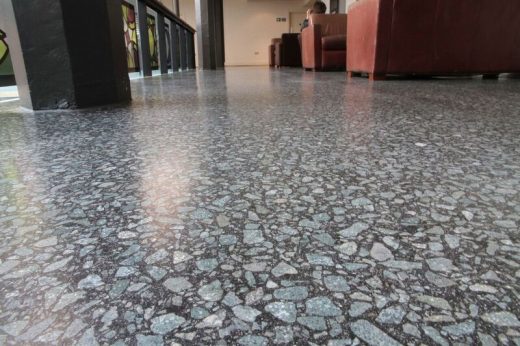Introduction:
Asphalt is petroleum liquid with a very high viscosity. In many settings, asphalt flooring is the best solution. Asphalt mastic is created by mixing asphalt and sand in a 2:1 ratio when used as a flooring layer over a concrete subfloor. In place of sand, asphalt can be used to create a marble mosaic. Aside from asphalt, inert chemicals and mineral pigments are used to create asphalt tiles.

Fig: Asphalt flooring
Courtesy: designingbuildings.co.uk
What is Asphalt Flooring?
The components of asphalt flooring are asphalt, chrysotile, paint, and glass beads, resulting in a smooth coating. It has a flat profile of around 1/8 to 3/16 inches and is indestructible, flame-resistant, cheap, and simple to shape. This flooring is well-known for its attractive appearance, as well as its anti-slip and soundproof properties, as well as its resistance to water, dirt, grease, acid, and dirtiness.
Asphalt flooring expands when wet, even when minimal maintenance requirements are followed; linoleum, on the other hand, can be installed in a quarter of the time and is resistant to viruses, acids, oils, and animal fats. Its use becomes appropriate for the ground temperature to be below 27 degrees Celsius.
Where is Asphalt Flooring Used?
Asphalt flooring can be seen in various settings, including parking lots, flyovers, footbridges, and verandas. On an existing concrete slab, its installation time is drastically reduced. It’s a smart idea to widen passageways like patios and bridges. As a result of its toughness and longevity, asphalt flooring is widely favored across the globe. The garage, the flyover, the walkway, and the runways are just a few places where asphalt flooring may be useful.
Preparation and Installation of Asphalt Flooring:
- Clean the old floor and remove any cement, sand, or other debris before installing it. Massive equipment is required to break up the old asphalt. All debris from demolition must be removed, and the area must be thoroughly cleaned before the installation can begin. Additionally, cut up the smaller trees and grasses. More tanks in the space between buildings are wasteful and may lead to complications.
- Make sure the water drains correctly by setting the lean after cleaning. If the concrete is poured properly, it will delay the collapse of your floors. Water can pool at the edge of the floor because of the design.
- A well-installed sub-base is crucial since it serves as the flooring’s central support system and provides a stable foundation. The sub-base serves as an ice bridge in cold weather, minimizing fissures created by the time-consuming thawing process.
- It is time to proof roll once the sub-base has hardened and been compacted. The stability of the basic pattern, essential for the asphalt and the load, is ensured by proof rolling.
- Layer in your folder structure. The smooth zone of the base and the sub-base must be located before you can set your folder base. Finally, install the new asphalt flooring once a binder coating has been applied. When properly assembled, the sand, oil, and microscopic particles that give it its black appearance can be transformed into a soft, brilliant, and endearing floor.
- Your new asphalt joints for pavement, highway, and parking space are the last touch because you’ll need to transition between the two configurations seamlessly.
Repairs to Asphalt Flooring:
Mastic asphalt flooring is convenient because it doesn’t have to be completely removed if damage occurs. Identifying the damaged section of an asphalt floor is the first step in repairing the damaged section. As a next step, the asphalt will be pliable again by applying a “hot poultice” around the circumference of the damaged region. The maintenance worker will use a bolster and hammer to break up the asphalt before shoveling it away.
The exposed edge is cleaned for a broken joint, and heating felt or staple tissue is applied. Depending on the desired thickness, the flooring is layered with asphalt in one or two layers.
Then, the asphalt is recreated and reheated to produce a fusion joint with the rest of the mastic asphalt. As a final step, coarse sand is rubbed into the asphalt, allowing the material to cool.
Advantages of Asphalt Flooring:
- Placing the asphalt flooring catalog in a parking lot will result in a sturdy and long-lasting plane, which will be evaluated for its strength and durability.
- Pavement made of asphalt will have bitumen applied to make it even more watertight.
- Particles are less likely to stick to asphalt flooring than concrete because of the material’s structure.
- Asphalt flooring bases can help smooth out imperfections like sharp corners and edges that would otherwise damage your floor.
- With asphalt, materials may be revived and used again because it does not degrade.
- Asphalt walkways on balconies are a terrific choice for a practical and long-lasting floor.
- Healing with asphalt is rational and straightforward; if you administer asphalt, you will need less supervision.
Disadvantages of Asphalt Flooring:
- Asphalt flooring requires more maintenance than concrete since it must be sealed every four to five years with plaster to keep it from cracking. There will be instances when flying isn’t necessary.
- For the best results, heat the material to between 250 and 350 degrees Fahrenheit before applying it to the asphalt floor of the airplane. Then, coat it with sand or other materials for added compression and longer service life.
- Asphalt will deteriorate if you haven’t varied and positioned it properly, and you can repair and level off cracked or uneven surfaces before flooring.
- In the future, asphalt will be made from fuel, which causes harm when the organic compound is removed—reverse asphalt, which can be used to build asphalt concrete with no organic compounds.
- Asphalt flooring cannot be laid without a tracked truck and the right accessories.
Conclusion:
Asphalt flooring is becoming increasingly popular due to its numerous useful properties, such as toughness, elasticity, durability, water resistance, acid resistance, and aesthetic appeal. Since mastic asphalt flooring is both silent and nonslippery, it may be used anywhere from factories to loading platforms to swimming pools and terraces.
References:
1. “Mastic Asphalt Flooring.” Mastic Asphalt Flooring – Designing Buildings, www.designingbuildings.co.uk/wiki/Mastic_asphalt_flooring. Accessed 10 Nov. 2022..
2. Asphalt, Heritage. “Asphalt Contractors: Heritage Asphalt #1 UK Asphalt Company.” Mastic Asphalt Contractor, masticasphaltcontractor.co.uk. Accessed 10 Nov. 2022.
3. “What Is Asphalt Flooring: Its Advantages and Disadvantages.” Real Estate Forum by NoBroker.com, www.nobroker.in/forum/what-is-asphalt-flooring. Accessed 10 Nov. 2022.
4. “Mastic Asphalt Flooring | the Construction Civil.” The Construction Civil, 28 Sept. 2012, www.theconstructioncivil.org/mastic-asphalt-flooring.
5. Geeky. “Pros and Cons of Asphalt and Concrete | Richmond Blacktop.” Richmond Blacktop, 19 Aug. 2016, richmondblacktop.com/blog/pros-cons-asphalt-concrete.
6. Asphalt, London. “London Asphalt.” London Asphalt, www.asphaltroofinglondon.co.uk. Accessed 10 Nov. 2022.
























Fair selection is requite for civil Engg. so that civil engineers can do some what better their nation.In present due to lack of transparency in selection, civil engineers are unable to improve their working culture.Working culture automatically improve if selection became fully transparent. Now a days it is fully flopped in India.It can not make fully transparent by single man. Now have urgent need for joint effort so that we can success.Selection procedure should be change at once.Parameter of selection should be changed immediate.Our present government is trying it,s best review selection parameters.Present government detained interview for some junior posts. We can hope it will be some what better for public.
Nice Web site
I am a CIVIL ENGINEER from Orissa ,India . I am interested to work in a architectural field .I have a good knowledge in AUTOCAD & REVIT ARCHITECTURE .
I have completed my diploma in civil engg. . now wt to do …
Its better to do b.tech in university not private colleges k
If you want to do work, find any good job and enroll in distance education in Civil Engineering from AMIE.
Its great privilege to be a civil engineer
what are the short term courses available after B.E. civil engineering
hello friends please help me, CADD or CAD is better for autodesk certificates
I am studying diploma civil engineering i have one answer, Question is why bricks are red colour which chemicals are used
concrete cube test results & formula. kindly send me , thanks
I am ME structure engineering student, I use superplasticizar in my thesis project plz give information how much percentage add to construct SCC…
HOW TO COMPUTE THE DEADLOADS ON RAILWAY BRIDGE?
Done a plaster on dead wall external side two coat, & internal side one coat on internal side.
& Apply external of dead wall texture with two coat pain but in rainy season leakage proble has arrived . water came from external side to internal side.
My question is that why water came from out side?????
Leakage is common in brick masonry and plaster is porous in nature. It is better to go for waterproofing to get rid of psychological unease and damge of buildings.
An increase in temperature on the top fibre of a simply supported beam will cause
(a) Downward deflection
(b) Upward deflection
(c) No deflection
(d) Angular rotation about neutral axis
can you explain ???
downward deflection
think about what happens when materials are heated, specifically how they change in length in this instance. If the top of the beam is longer than the bottom, what might happen to the beam?
Downward deflection
upward deflection
What are the quality tests to be performed for concrete hollow blocks?
Why we use low grade concrete for the soft piles in secant shoring. how can i justify??
How can i know steel sheet gauge to MM
How can I find steel sheet or steel round pipe gauge to mm ?
Need some help with connecting proposed surface with existing roads and buildings in Civil3D.
what is the difference between WMM(Wet mix macadam) & DBM(Dense bitumine macadam) ?
Respected Sir,
please explain what is the design procedure of concrete pedestal transfer industrial steel column load to footing